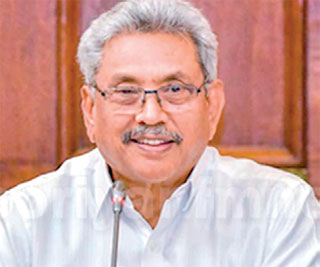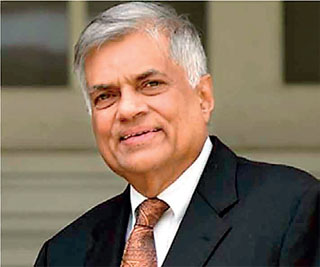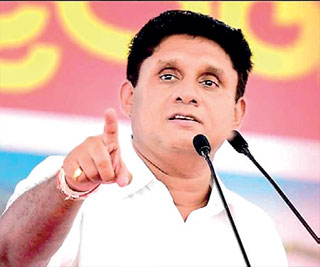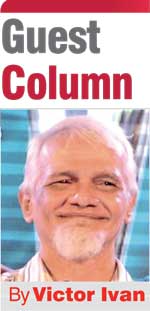Thursday Apr 24, 2025
Thursday Apr 24, 2025
Friday, 3 June 2022 00:18 - - {{hitsCtrl.values.hits}}

President Gotabaya Rajapaksa

Prime Minister Ranil Wickremesinghe

Opposition Leader Sajith Premadasa
 The readiness of the President and Prime Minister to open the doors for a “public-participatory” reform program for a profound and positive change in the system can be considered as a unique revolution likely to take place in the context of the youth uprising.
The readiness of the President and Prime Minister to open the doors for a “public-participatory” reform program for a profound and positive change in the system can be considered as a unique revolution likely to take place in the context of the youth uprising.
At a time when the heat of the youth uprising was on the rise, I had a strong curiosity to know what the President was thinking about it. How does he feel about having a reform program? Is he in favour of a reform program? If so, is he ready to open the doors for it? How far is he prepared to proceed in that direction? I was inquisitive to know that I compiled a document including the major reforms that I always used to advocate and submitted it to the President; in the meantime I made a request for a meeting with the President through a Planter known to me, who knew the President well, to have a discussion with him on my proposal.
The first recommendation of my proposal was that the President should relinquish his position of being above the law through an amendment to the Constitution as a symbolic gesture to demonstrate to the public that he is willing to open the door for reforms. The concluding recommendation of my proposal was that the United Nations too, should be involved in the reform program as an observer so that no one could disrupt the process in the interim. The President discussed the program with us for nearly two hours, and stated that he approves it. However, I suggested that it is desirable and better that he study the proposal in depth, consult his legal advisers and inform the Planter if there are any points that he finds difficult to agree with.
Three days later, the President had informed the Planter that the concept of “Interim Constitution” referred to in my proposal was not clear to his legal advisers. I then sent to the President a digital copy of a document published by the International Institute for Democracy and Electoral Assistance (IDEA) in Sweden on the subject. IDEA was an initiative proposed by the Swedish Parliament in 1991 mandated with the responsibility of sustaining and promoting democracy worldwide.
Thereafter, a discussion was held on 20 May with Ranil Wickremesinghe also on the proposed reform program subsequent to his appointment as the Prime Minister at a time the country was moving towards a massive crisis situation. He too was of the opinion that it was essential to direct the country to a reform program that would bring about a complete transformation of the system. The President had already informed the Prime Minister of my discussion with him, and the Prime Minister asked me to put my proposal into a formal frame and present it to him as soon as possible.
Produced below is the document that I prepared and submitted to the Prime Minister in response to his request. The main thing I wanted to do was to open the doors for a reform program that would result in a profound change in the system. It was not the desire of mine only, but also the aspiration of those who were involved in the “People’s Movement for Reforms” that contributed to the formulation of this program. It has been formulated in such a way that the public could proceed with it by adapting the content of it as they see it fit.
Sri Lanka is now in a critical situation where it is imminent to fall into a deeper abyss that is not easy to manage. The greatest possible tragedy that is looming ahead could be brought under control only if Sri Lanka is able to face the challenge collectively and concertedly in the political and social sense thereby ending the anarchy that reigns in the socio-political arena. The proposed reform program will certainly help unite the political regime and society which remains divided at the moment. It will enable us to change the outdated and corrupt system without a bloody revolution. Also it will create a strong environment to resolve the balance of payments crisis as well.
Recreating Sri Lanka, a brief reform plan:
1. The main objective:
The main objective of this reform program is to eliminate the ills of the existing political system which is corrupt, inefficient, unfriendly and outdated, and replace it with a better and wholesome system that is corruption-free, efficient, people-friendly and modern, and thereby rescuing the country from the present unfortunate predicament and create a dignified Sri Lanka that all can be proud of.
2. The methodology proposed to be adopted to achieve the objective:
This reform program is proposed to be implemented with the support of the President of the country, the ruling party of the Parliament headed by the Prime Minister, the main Opposition headed by the Leader of the Opposition and the general public; it should be conducted in two main phases and within a recognised legal framework based on a system of people’s participation which is transparent and accountable to the people and the legislature.
3. Expected major changes:
I. To create a disciplined and modern civil society endowed with pluralistic attitudes and capable of acting with the sense of rights and responsibilities. (a) Educate the society and instruct the citizens with necessary knowledge to achieve this purpose, (b) abolition of outdated feudalistic caste system in its entirety, (c) conduct investigations on disappeared persons, do them justice and formulate appropriate policies to prevent recurrence of such incidents in the future, altogether, (d) look into the grievances of all community groups (ethnic, religious, gender and cultural) that may be considered oppressed, marginalised and vulnerable, and grant them equal human dignity and rights enjoyed by the rest of population, (e) ensuring gender equality, (f) strengthen the freedom of citizens which is of diverse nature, (g) establish a statutory framework that confers a significant group of citizens the right to intervene directly and democratically in important issues of governance when it is essential to do so, rather than restricting the exercise of the sovereignty power of the citizens which is their right only at the elections. Considering the methodologies such as public initiation, recalling, and alternative referendum that some other countries have adopted granting the citizens to intervene in a direct democratic manner, it would be possible to set up a system in which a significant group of as many as three to four hundred thousand citizens were allowed the right to submit proposals to Parliament. When a proposal is submitted with a specified number of signatures, a system could be set up to include it in the Order Paper of Parliament, debate it and put it to a vote.
marginalised and vulnerable, and grant them equal human dignity and rights enjoyed by the rest of population, (e) ensuring gender equality, (f) strengthen the freedom of citizens which is of diverse nature, (g) establish a statutory framework that confers a significant group of citizens the right to intervene directly and democratically in important issues of governance when it is essential to do so, rather than restricting the exercise of the sovereignty power of the citizens which is their right only at the elections. Considering the methodologies such as public initiation, recalling, and alternative referendum that some other countries have adopted granting the citizens to intervene in a direct democratic manner, it would be possible to set up a system in which a significant group of as many as three to four hundred thousand citizens were allowed the right to submit proposals to Parliament. When a proposal is submitted with a specified number of signatures, a system could be set up to include it in the Order Paper of Parliament, debate it and put it to a vote.
II. Establish an advanced democratic system of governance in which there is no space for the Head of State to be above the rule of law, and the rule of law is enforced strictly and equally so that the sovereignty of the people is well-represented and operative. (a) abolish the Presidential system and establish a bicameral Legislature with a nominal President and assign the responsibility of governing the country to the Cabinet of Ministers headed by the Prime Minister. (b) Explore the causes of the decline in the standard of Parliament and abolish altogether the opportunity given the Members of Parliament to transact business with the Government and take appropriate measures to establish an efficient and effective parliamentary system. (c) Enact laws to ensure the internal democracy of political parties and grant the Election Commission the powers to monitor it. (d) Introduce a method to eliminate the distance between elected representatives and the voters, and introduce a simpler electoral system with lesser representation on the National List that replaces the district system with a system based on electorates so that the huge costs incurred by candidates in contesting elections could be reduced. (e) Empower the Election Commission to enact laws to restrict the funds received and expended by political parties and candidates during elections and delegate powers to the Election Commission to monitor such activities.
III. Identify the causes of the decline of the judiciary with the assistance of the judiciary itself and make necessary reforms with the view to establishing a strong, efficient and independent judiciary. (a) Restore the judiciary with the full “power of review”.
IV. Considering the immense importance of the media in a democratic political system and the strengths and limitations of the role of the media in Sri Lanka, as well as the horrendous repressions that have been inflicted on it from time to time, introduce policies, rules and regulations conducive to ensuring the freedom and enhancing the quality of the media, and also holding the media accountable to society
V. Investigate the roots of corruption which has overwhelmed the State, its system of institutions, and the political and bureaucratic regime of the State like a terrible cancer, and formulate strong and pragmatic reforms to eradicate the menace of corruption altogether
VI. Formulate a “National Policy” framework that incorporates all important aspects of development so that the development process of the country is maintained as a permanent entity that does not change when the governments change; and also to ensure that the possibility of arbitrary actions by politicians or bureaucrats in that regard could be completely eliminated.
VII. The Provincial Council system was introduced with the intervention of India, to establish a kind of sub-national level administration particularly for fulfilling the aspirations of the Tamil people. In view of the violent atmosphere that prevailed in the country at the time of its introduction, both countries did not have the ability to assess the facts relating to it in their correct perspective, calmly and logically. The fact that the Provincial Council system is in a chaotic condition can be considered as an unavoidable consequence of the circumstances under which it was set up. Therefore, it is necessary that the appropriate reforms are made with the concurrence of India so as not to jeopardise the aspirations of the Tamil people and to regularise the Provincial Council system eliminating its present chaotic condition.
VIII. Investigate the drawbacks of the Attorney General’s Department and the Police, the two main law enforcement agencies, and introduce reforms that will make the two agencies more effective and efficient.
IX. The enormity of the public service (there is one public servant for every 15 people) and the corruption and inefficiency inherent in it, is another major factor contributing to the failure and bankruptcy of Sri Lanka. The Government agencies responsible for collecting tax and issuing licenses are plagued by rampant corruption. Certain government institutions that are continued to be run at a loss despite their potential for earning profits can also be considered as a crucial factor that has contributed to the bankruptcy of the country. The country’s defence spending also remains at a level which is unbearable to the country. It is important to look into this situation and make necessary reforms to reduce the number of employees in the public sector and make the public sector more efficient and effective.
X. Adoption of a new constitution based on “People’s Participation” to legalise the proposed reforms.
4. Violation of the Constitution:
(a) Deliberate violation of the Constitution should be made a punishable offense (b) Amendments that undermine or distort the democratic essence of the Constitution should be outlawed, as in India, (c) the Supreme Court shall be conferred the necessary power to do that .
5. Implementation of the reform program:
I. A Constitution Formulation Committee consisting of the representatives of Parliament and representatives of people’s organisations shall be set up to plan, formulate and implement the reform program. (a) It shall consist of 50 Members elected from Parliament and 100 Members of the representatives of public organisations. (b) The 50 Members of Parliament shall include the Prime Minister, the Leader of the Opposition and the Leaders of the Parties represented in Parliament. (c) The 100 Representatives of the People should be elected in a way that is acceptable and represents all sections of society, with representatives who are capable of contributing to this cause, creatively. (d) The President shall have the ex-officio authority to attend the committee meetings.
II. All meetings of the Committee should be conducted in a transparent manner visible to the public; and a substantial number of counters should be maintained to allow the public to express their views in this process.
III. The United Nations Organization also should be involved in this program as an observer; and secure its technical advice on how to make the reform program formalise and pragmatic; the experts and resource persons to train the major teams involved in this program should be secured from the United Nations Organization. The committee should also have the power to appoint advisors needed for it.
IV. Implementation of the reform program should take place in two main phases (a) Phase 1: Appointing Officers’ Committees or Commissions for fact finding and maintaining them, (b) initiation of necessary reforms to give effect to Judicial reforms under Article III, Media Reforms under Article IV and reforms to the new system of governance up to the holding of an election under Article II as outlined above. (c) The election should be held as a means to elect the representatives to the Constitution Assembly, in addition to electing the representatives of the legislature, (d) the tasks included in the first phase should be completed within a year.
V. Phase II of the reform program:
(a) The political party that comes to power, in addition to governing the country as an all-party government, should complete the reform program included in the Interim Constitution as prescribed therein. (b) After the election of the new Parliament, the Constitution Formation Committee set up in the first phase shall cease to operate and the Parliament should become the authorised body to carry out the task of constitution making and the remainder of the reform program. (c) Even after the dissolution of the Constitution Formulation Committee, the work of the formulation of a constitution should be maintained in a transparent manner, and the committee should maintain a transparent framework that allows the public to actively participate in the legislative processes (d) The draft constitution shall be approved by a two-thirds majority of the bicameral legislature; then it should be approved by the judiciary and ratified by the public in a subsequent referendum.
6. The interim constitution:
When a country has been plunged into an unprecedented crisis following a catastrophic collapse of the socio-political system and the economy of it, it would not be possible to use the old or existing constitution successfully any longer to change the old system and move into a new system. “Interim Constitution” is a successful and proven method adopted by many countries which have plunged into similar crises, as a bridge to transit from the old system to a new one while maintaining the legal continuity and integrity of the constitution; this has been acknowledged as a valid methodology by international law also. It is very difficult for our country which is in a great crisis at the moment to move into a new system using the old constitution.
Adopting an interim constitution can be considered as the best way to overcome this difficulty. Since it is an interim measure only, applied until a new constitution is enacted, and also it provides a guarantee that a referendum shall be held to obtain public approval for the new constitution once it is formulated, and also to repeal the existing or old constitution, the need does not arise for the interim constitution to be subjected to a referendum prior to the completion of all activities of reforms program.
The interim constitution should be drafted by the Constitution Formulation Committee. It should include the overall reform program and the details of how it should be implemented, the timeframe, and all other necessary factors. The Constitution Formulation Committee derives its power from the interim constitution. It must be presented to Parliament and passed by a two-thirds majority.
7. Public education:
In order for this reform program which requires a greater public involvement to be successful, there should be an optimal level of a strategic program of publicity and education aimed at educating the public and raising their awareness of it. The program must have the capacity to reach at least 80% of the total population.
8. Concluding the reform program:
The reform program will be concluded with the referendum held for obtaining the public approval for the new constitution, and the second phase of it should be completed in less than three years.
Discover Kapruka, the leading online shopping platform in Sri Lanka, where you can conveniently send Gifts and Flowers to your loved ones for any event including Valentine ’s Day. Explore a wide range of popular Shopping Categories on Kapruka, including Toys, Groceries, Electronics, Birthday Cakes, Fruits, Chocolates, Flower Bouquets, Clothing, Watches, Lingerie, Gift Sets and Jewellery. Also if you’re interested in selling with Kapruka, Partner Central by Kapruka is the best solution to start with. Moreover, through Kapruka Global Shop, you can also enjoy the convenience of purchasing products from renowned platforms like Amazon and eBay and have them delivered to Sri Lanka.
Discover Kapruka, the leading online shopping platform in Sri Lanka, where you can conveniently send Gifts and Flowers to your loved ones for any event including Valentine ’s Day. Explore a wide range of popular Shopping Categories on Kapruka, including Toys, Groceries, Electronics, Birthday Cakes, Fruits, Chocolates, Flower Bouquets, Clothing, Watches, Lingerie, Gift Sets and Jewellery. Also if you’re interested in selling with Kapruka, Partner Central by Kapruka is the best solution to start with. Moreover, through Kapruka Global Shop, you can also enjoy the convenience of purchasing products from renowned platforms like Amazon and eBay and have them delivered to Sri Lanka.